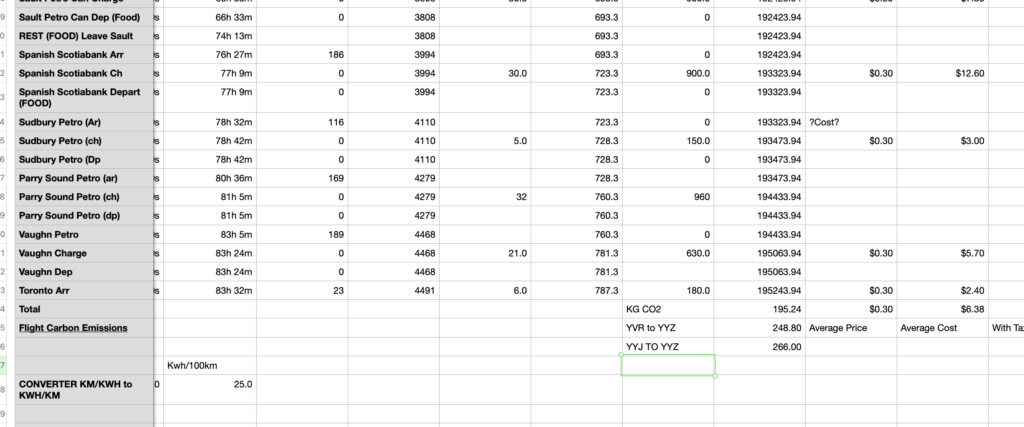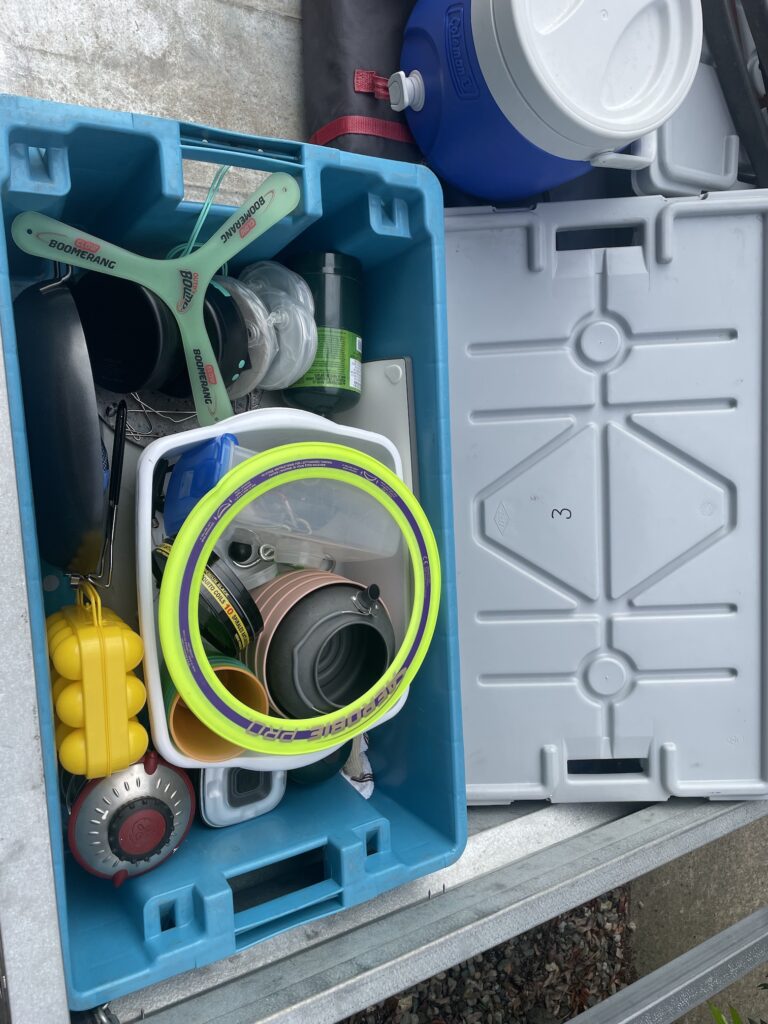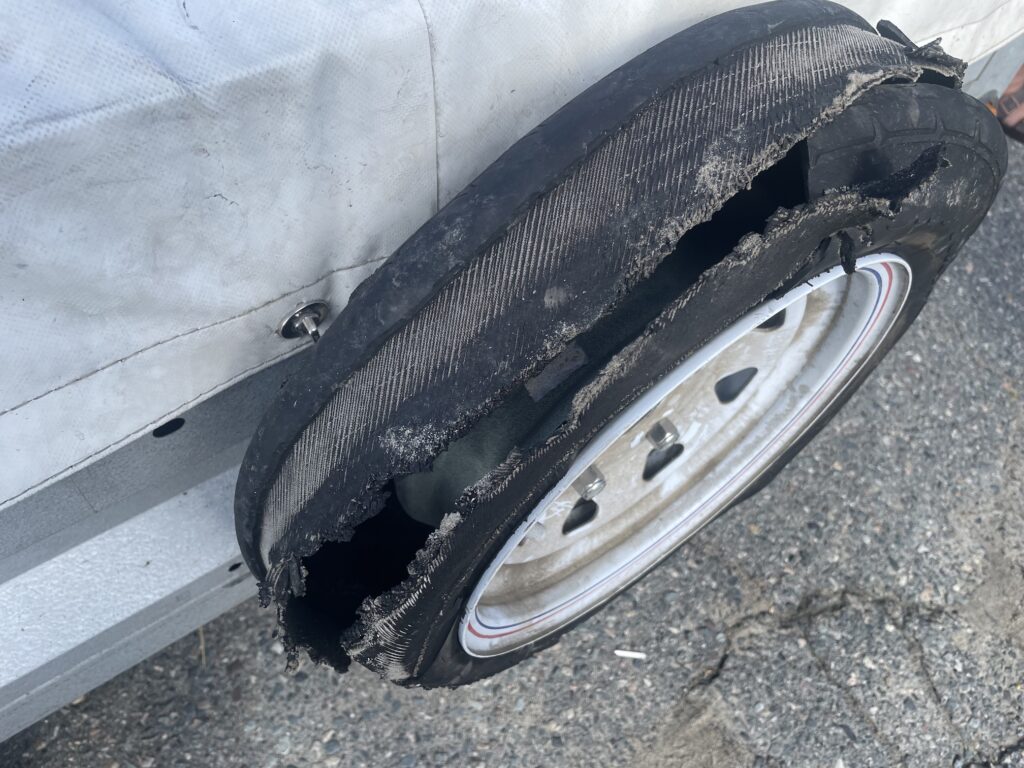Table of Contents
Corrections: I have made a number of corrections and refinements as I have walked through the associated spreadsheet. This is current to Jan 10, 2023.
- Prologue – The (forced) EV Journey
- A Carbon Conundrum en Español
- Three Things that Worked, and Didn’t
- The Stats – Counting Carbon, Kilowatt Hours, and Kilometres
- Takeaways from the #EVCrossCanada Experience
- The Twitter Threads
- Original Carbon Across Canada Post (opens in new window)
Prologue – The (forced) EV Journey
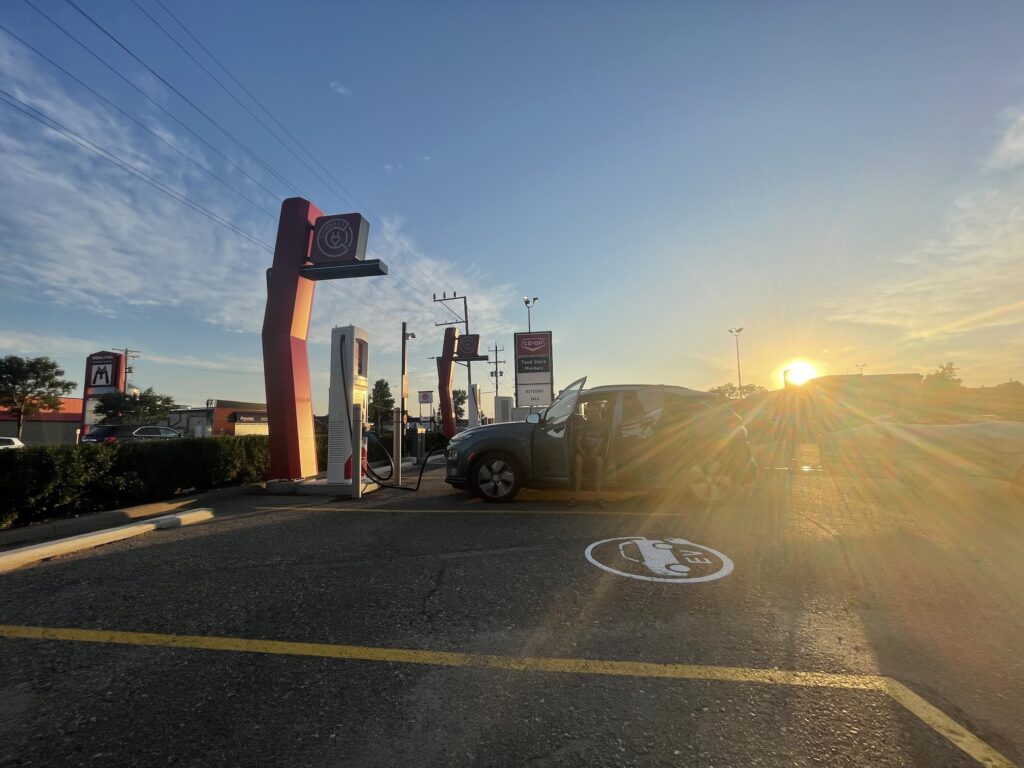
Dear reader, if you’re here you’re already interested in electric vehicles (EVs). Perhaps you already own one, or perhaps you’re just curious, but like so many of us you’re trying to figure out if they and the infrastructure they need are actually ready for anyone to use and take over from the internal combustion engine (ICE) vehicle that has dominated for nearly 100 years. I’m wondering the same thing. This summer I went on a cross-Canada journey with my family, in part, to find out.
I hope the information and opinions expressed below help you in your journey and perhaps even help make the EV experience better for all of us if the trajectory it is on today can be refined. Please do share this to anyone who you think might be able to take the experiences and recommendations and make life better for all of us.
I would also like to mention at the very beginning that this journey would have never happened, indeed it would not have been necessary, if Canada had a modern, interconnected, electrified, low-carbon land transport network. I’ve ridden Greyhounds across continents (USA/Canada and Australia) in the past. I’ve ridden trains across Europe as late as 2017. The current state of public transport and intercity/provincial transportation in Canada is an embarrassment but if we look at it positively, it is also a huge opportunity.
I made this journey because I was looking for alternatives to high-carbon, high stress commercial flying, but there are so many benefits to a robust land transportation network connecting a country like Canada. Please tell your MLA, MPP and/or MP that we need to rebuild our land transportation network, bus and rail, for the 21st century and consider joining Transport Action Canada and/or BC Wide Bus to gather momentum.
Thank you.
A Carbon Conundrum en Español
The real catalyst for this trip was something quite personal; reconnecting to my family roots. I’ve been going through the process of obtaining Spanish citizenship through my father’s birth in Spain. Unfortunately there are only two Spanish consulates in Canada, Toronto and Montreal. In order for myself and my children to go through the process it would require 4 separate visits for me and 2 for the kids and my wife. Since we’re in Port Alberni on Vancouver Island, it’s a huge travel commitment, with a potentially huge carbon footprint and significant cost.

I completed the first trip to the Spanish Consulate in March, using budget airlines and 72 hours of travel life I will never get back.
I ran the CO2 numbers and tweeted about them (you can see all the threads in “the twitter threads“) and I blogged about them.
Our 2019 Hyundai Kona Electric has been a wonderful car, and since there are no viable bus or rail alternatives in Canada, it seemed as though it was the only alternative to flying.
I made a spreadsheet to figure out how to drive the Kona across Canada and if there would be any benefit on CO2.
We had always wanted to see Canada as a family. My kids are in high school so time with them for family trips is coming to an end. The pandemic robbed us of a couple summers, so it seemed the stars were aligned, the time was now to actually experience a cross country journey, all the way to PEI and back, camping, motels, family, and counting carbon all the way along.

And so, a journey was born. It took us to some very random places. Like this poorly designed parking lot on a hill in Owen Sound, Ontario.
Below are maps of our original plan and our actual route. Nine National Parks, camping in 5 different spots and covering a huge variety of territory. We nearly did it all!
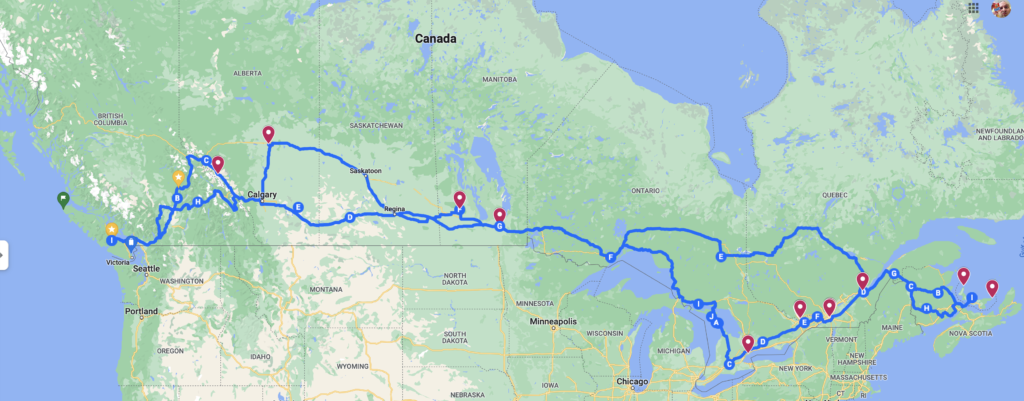
The biggest difference was not going the super-north Quebec/Ontario route.

If we had had an RFID card for Quebec Hydro’s Electric Circuit network we could have done the original northern Quebec portion through Lac Saguenay and Amos. But the Ontario portion only had 3 IVY chargers and not a lot of information on Plugshare about how reliable the stations were. It was a risk we didn’t want to take so we went through North Bay and Sudbury instead.
Canada is incredible. I posted pictures of our entire journey on an iCloud album so you can check it out!
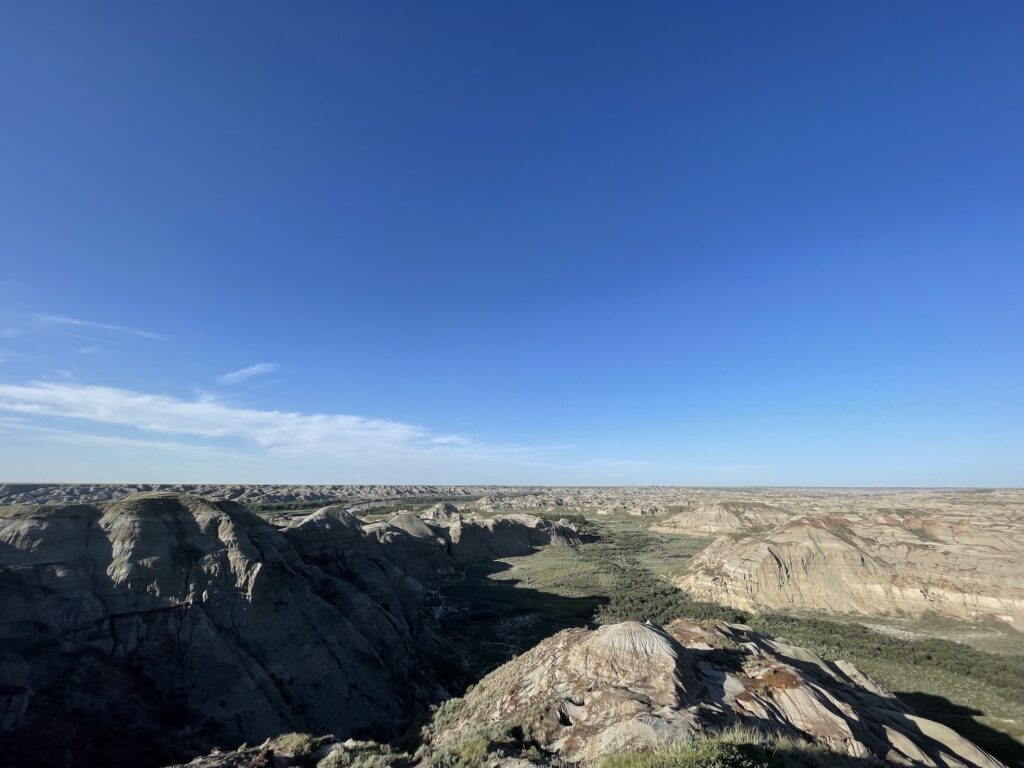
Three things that Worked or Didn’t
Worked: The Trailer!
To our surprise and relief, the small utility trailer (available at all major stores) performed very well. The Kona Electric (2019) is not recommended for towing, but I installed a hitch anyway after seeing many others do so.
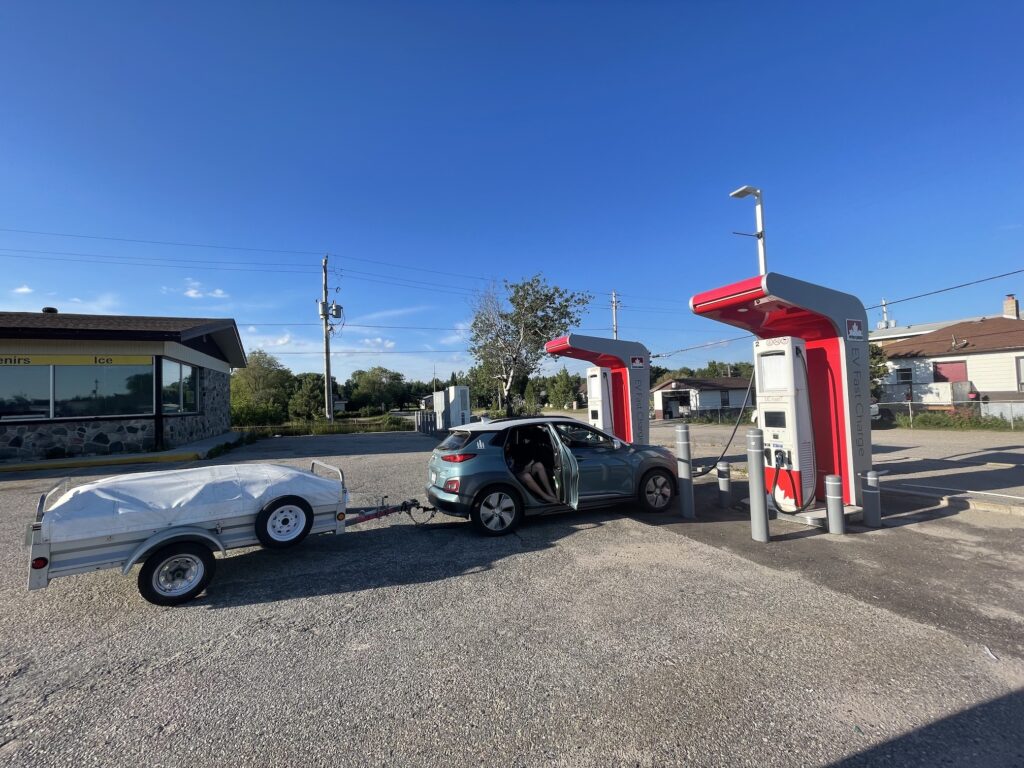
It performed flawlessly and with no trouble pulling the roughly 181kg/400lbs trailer with about 206kg/450lbs of stuff stored under the tarp plus the stuff and people in the car.
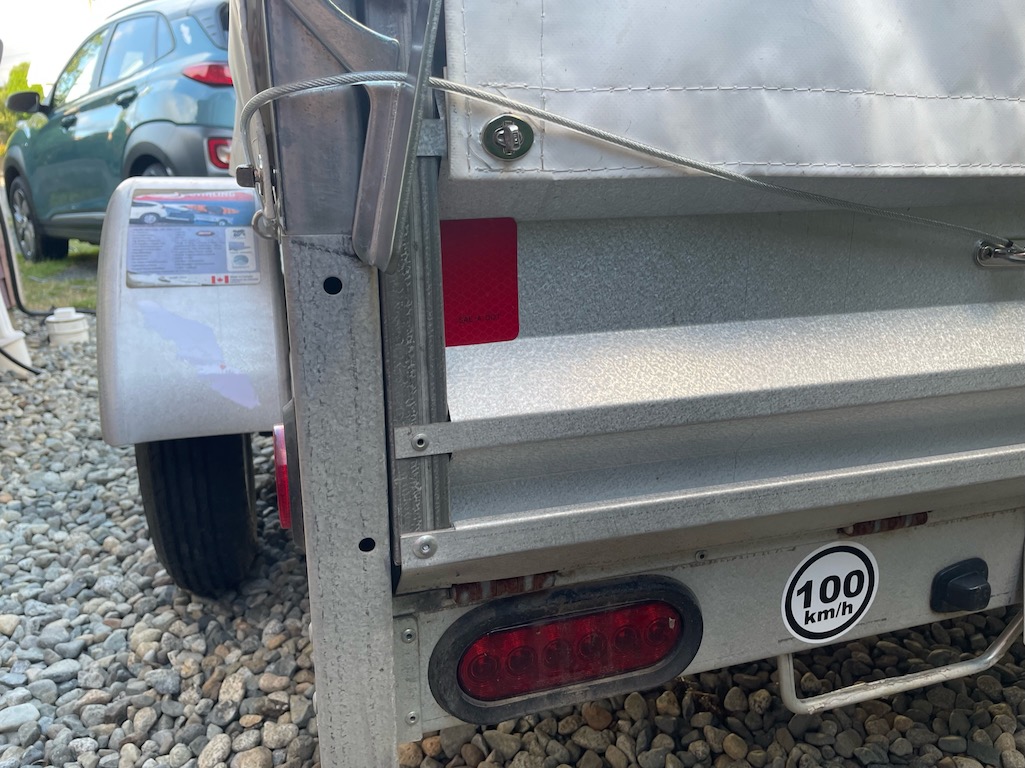
The lights came on nearly every time (dielectric grease helped keep that going) But the biggest advantage were the ‘fish totes’ we used to store our gear and the custom tarp we used to cover and secure it. The tarp had enough give in it that we could put everyone’s bags and pillows on top of the bins, plus add some souvenirs along the way, and the tarp stretched over all of it and kept it secure and dry. We went through some impressive downpours and nothing ever got wet and we maximized the space inside the car for people, and visibility.
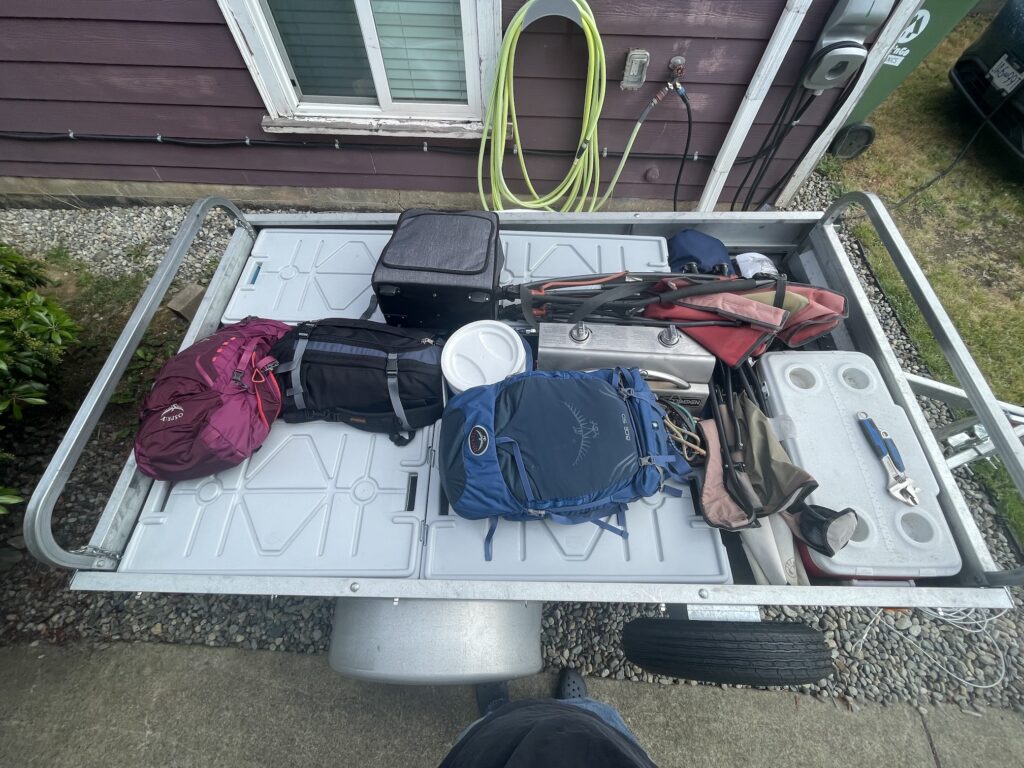
The trailer (or at least its tires) is only rated to go 100kph, so that was our speed limit throughout the trip. I may have gone a little more than that when the situation called for it, but that was also a good limit to preserve battery power.
Our only mishap with the trailer was one long day between Quebec City and Sudbury, the day everything went wrong…. after a long, frustrating day, a trailer tire blew at 11PM on an empty stretch of road just east of North Bay. Had we gone our original route, this would have happened somewhere in northern Quebec near Amos, QC or Timmins, ON. I’m glad we didn’t go that way. I think it’s safe to say 10,000km is the limit for these tires. We bought two new ones the next day in Sault St Marie.
You can see more about the trailer and cover at this blog post.
Didn’t Work: A Better Route Planner (ABRP)
ABRP is a popular app used by EV drivers to plan long distance journeys. It takes into account the efficiency of your car and predicts where you should stop to charge along the way. I created plans for every leg of our journey and it did that job very well.
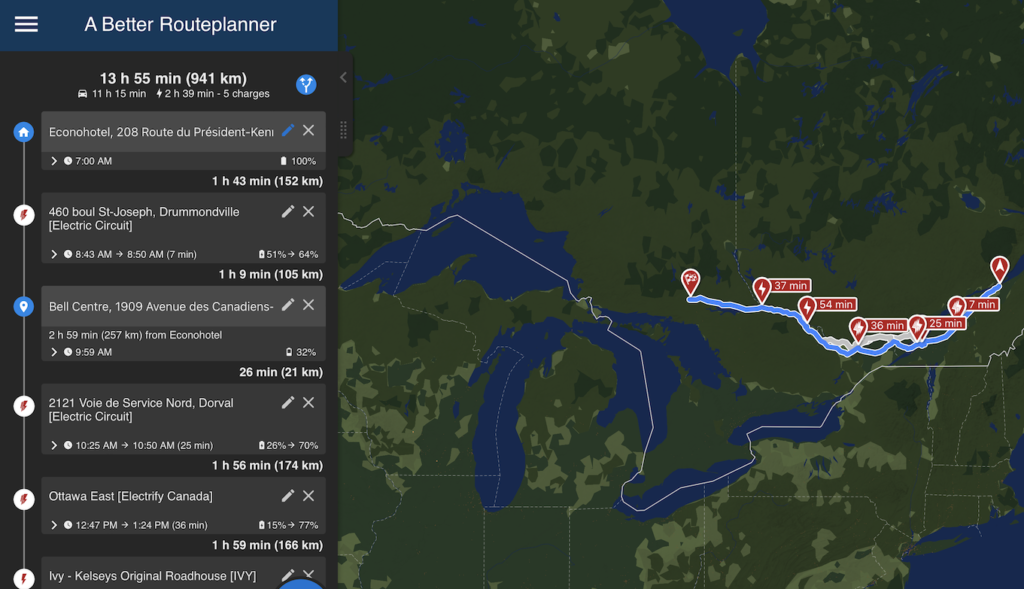
Unfortunately, when it came time to hop in the car and use the app for navigation, things didn’t go as well. If there was ever a detour in our route, which was pretty often, it often crashed or overheated the phone as it tried to recalculate. I had bought a small dongle for the car that linked it directly to ABRP so it had live data from the battery. This was super cool, but it again seemed to overtax the app and phone (a new iPhone mini).
In the end, as we got more comfortable with knowing our range, we simply used our own estimates to figure out how far we needed, how much battery we needed, and where to charge. I wouldn’t recommend it as a daily navigator… but as a planner, ABRP did that job well. And that brings me to another What Worked.
Worked: Plug Share
Absolutely indispensable. That’s how I would describe the popular Plugshare App
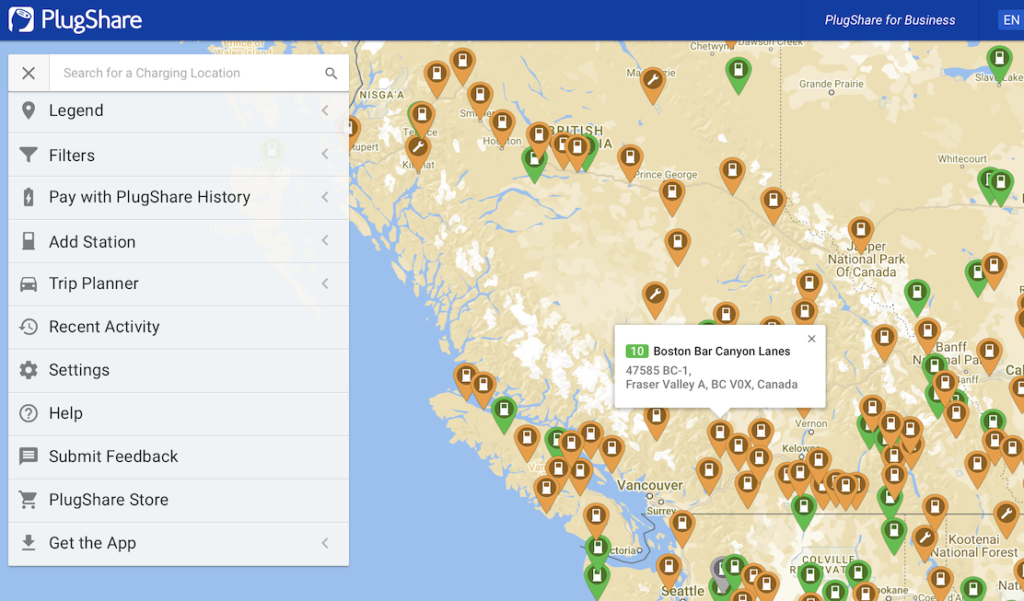
It is a user driven system that gathers all of the various networks of chargers into one app on your phone (or the web) and allows people to put in reviews, update it on the spot when they are charging at a station, and even allows the networks to deliver messages to their users (shout out to BC Hydro!).
The daily routine became to use our ABRP plan and then double check the charging stops on Plugshare. Then we used Plugshare the rest of the day to refine our journey and send the address for the next charge stop to Apple or Google Maps for navigation. We left a comment and a picture at every stop.
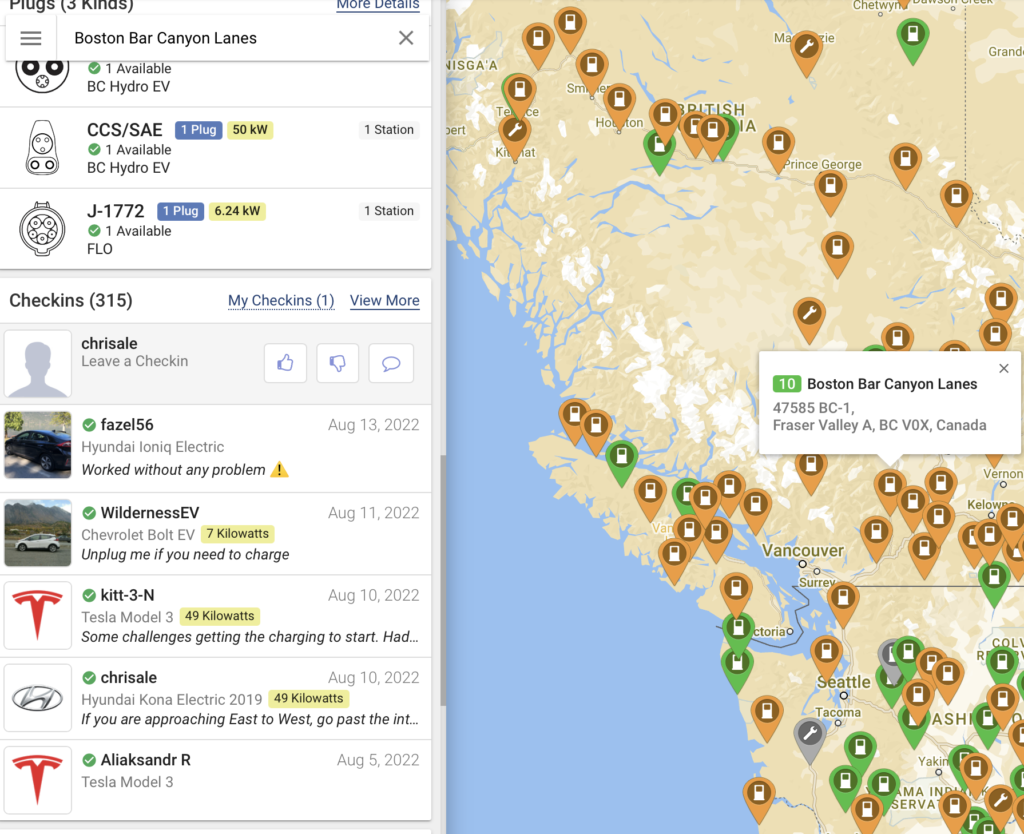
Not only could we see if a station was operating or in use, but it also allows you to report the power you get from a station, so we could see the real world performance and often used that to decide which stations to use and which to avoid.
The Stats – Counting Carbon, Kilowatt Hours, and Kilometres
Comparing Modes
On #EVCrossCanada we travelled 16,267km from Port Alberni, BC to Cavendish, PEI and back. Over that distance the car consumed 3,371 kilowatt-hour (kWh) of energy which at source, based on each provincial emissions factor, created 637 kg of CO2 in total. Let’s look at that compared to other modes. Reminder: this was a 32 day holiday for us, the car journey could be done in far less time, on a more direct route, saving time, money and CO2.
- EV = 2019 Hyundai Kona #EVCrossCanada with family of 4
- Air = Vancouver to Halifax via Winnipeg (ICAO Calculator, using kg of fuel, 3.16kg CO2/kg fuel, cheapest Expedia Sept 1, 2022)
- ICE = 2011 Toyota Prius C (our 2nd car, 5L/100km, CO2 factor, $1.80/L)
- Bus = This is a place holder. It’s not possible to go across Canada on a bus.
- Rail = VIARail to Halifax via Toronto/Montreal (CBC article and VIArail, Sept 1)
| Distance | Efficiency | Fuel | CO2 (tot) | CO2/person | Cost (4) | |
| EV | 16,267km | 4.8 km/kWh | 3,371 kWh | 637 kg | 159.3 kg | $1,145 |
| Air | 9,260km | 0.9 km/kg | 32,683 kg | 103,278 kg | 785 kg | $3,641 |
| ICE | 16,267km | 20 km/L | 813 L | 1,382 kg | 345 kg | $1463 |
| Bus | NA | NA | NA | NA | NA | NA |
| Rail | 11,000km (?) | NA | NA | NA | 956 kg | $3,896 |
Stats By Province
All Provinces are not equal! Especially when it comes to CO2, but also geography. Here are some province-specific stats, CO2 factors are total CO2 equivalent (includes CO2, Methane, and N2O) and were derived from this Government of Canada source accurate to 2019. Note: This is a more current source I’ve just found than what I used in the original twitter threads. The new CO2 factors are generally *lower* than previous, especially PEI, only NB went up!
Correction: I’ve updated, corrected and refined my spreadsheet so some values have changed over time.
| BC | AB | SK | MB | ON | QC | NB | PEI | |
| CO2 factor (gCO2eq/kWh) | 18 | 630 | 670 | 1.2 | 26 | 1.2 | 300 | 2.0 |
| Travel (km) | 1932 | 1865 | 1596 | 1307 | 5817 | 1561 | 1221 | 968 |
| CO2 (kg) | 6.5 | 258.9 | 257.5 | 0.3 | 31.7 | 0.4 | 81.8 | 0.3 |
| Cost | $71.17 | $164.62 | $137.55 | $66.03 | $462.27 | $90.22 | $96.82 | $66.45 |
| Efficiency (km/kWh) | 5.35 | 4.29 | 4.15 | 5.40 | 4.72 | 5.04 | 4.48 | 6.10 |
| Cents per km | 3.7 | 8.8 | 8.6 | 5.0 | 7.9 | 5.8 | 7.9 | 6.9 |
Note: PEI has a higher efficiency because unlike the other provinces, the vast majority of our travel on the Island was without the trailer. BC, Saskatchewan, and New Brunswick were exclusively with the trailer Alberta, Manitoba, Ontario and Quebec, was a mix.
Adding CO2 from Ferries
I did not include GHG emissions from BC Ferries (Departure Bay to Horseshoe Bay – return) or Ontario Ferries (South Baymouth to Tobermory – one way) in the table above so that I wasn’t “mixing” transportation modes. Also, neither company publishes GHG factors regularly and it’s even harder to know how many passengers were on the ferry “sharing” the CO2 load at the time. As a ballpark, based on journalist reporting I found before (see the aforementioned blog post), I would add 15kg for each ferry trip. That would add 45kg to our total bringing it to 682kg.
Digging into the EV Stats and Experience
Driving an EV is an experience. (They are really fun to drive btw. Even with a trailer, the “oomph” is always there if you need it!)
Driving an EV across Canada, while towing a small trailer, with a family of four for 32 days, is an adventure. It required planning to know where we needed to charge, how far we might get on each leg, where we would stop for the night, etc. So, I made a plan.
Here it is, The Drive Log Spreadsheet. Yes, I recorded every charge we made as best I could! Click the image to download the full spreadsheet.
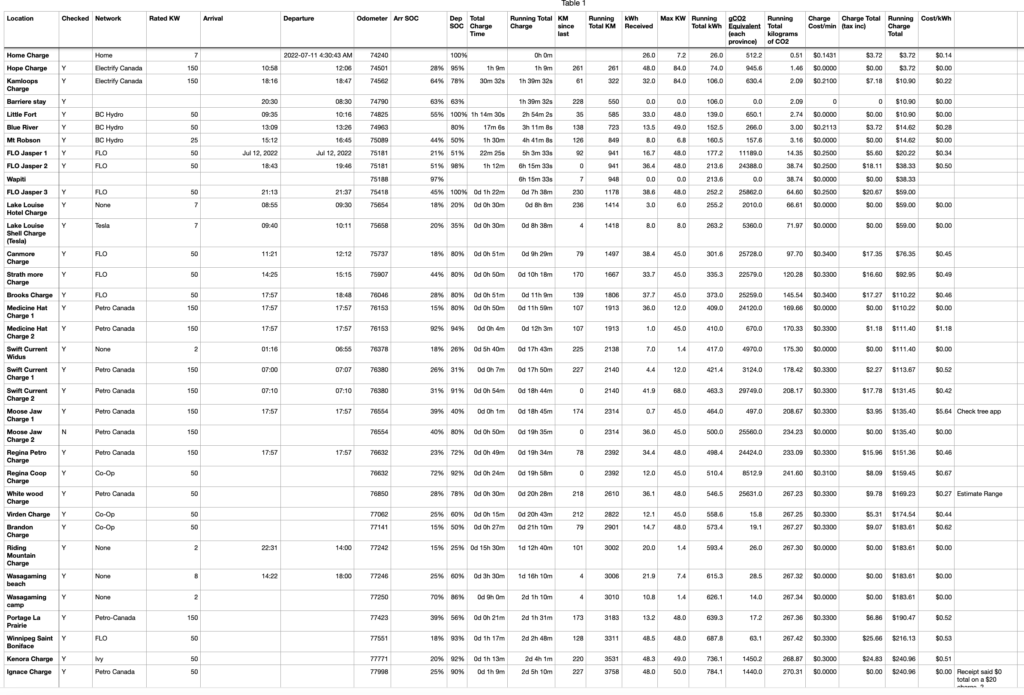
Here are some stats (if you have a stat in mind, leave a comment and I’ll try to add it!)
General Stats
- Odometer Start/Finish: 74,240 km / 90,504 km
- “Full Battery”: 64 kWh
- Total Travel: 16,267 km
- Total Days travelled: 32 Days
- Lowest Percent Battery: 9%
- Average % Battery arriving at charger (Approx): 37%
- Average % Battery departing charger (Approx): 71%
- Average efficiency over the journey: 4.8 km/kWh
- Prairie Efficiency: 4.7km/kWh
- Non-Prairie Efficiency: 5.0km/kWh
Charging Time and Power
- Total Charge Time: 7d 1h 35m
- Average Charge Time at Fast Chargers: 39m
- Total Charges (including slow charges): 137
- Total Energy Charged: 3,293 kWh
- Average Energy per Charge: 24 kWh
- Average distance between Charges: 136 km
- Average Power (all chargers): 40.5 KW
- Average Power (fast chargers): 50.8 KW
- Average power (slow chargers): 4.9 KW
CO2 Emissions
- Total CO2: 637 kg
- Average CO2 per charge (all chargers): 4.82 kg
- Average CO2 per charge (fast chargers): 5.5 kg
- Average CO2 per charge (slow chargers): 1.8 kg
Cost
- Total Cost: $1,145
- Average Cost per charge (all chargers): $8.19
- Average Cost per charge (fast): $10.15
- Average Cost per charge (slow): $1.59
- Average Cost per minute (all): $0.19
- Average Cost per minute (fast): $0.24
- Average Cost per minute (slow): $0.02
- Average Cost per kWh (all): $0.36
- Average Cost per kWh (fast): $0.42
- Average Cost per kWh (slow): $0.10
Takeaways from the #EVCrossCanada Experience
The first and second points below are really the most important points
- It’s absolutely possible to drive an EV, even towing a small trailer (450kg), across Canada without much worry.
- Without the apps, it’s nearly impossible to know where to find a fast charger since you can’t assume they are at a gas station. They are just as likely to be at a grocery store, fast food joint, or random outlet mall. This is a big potential barrier. “Tech-Free” signage needs to be better.
- Get all the RFID cards! BC Hydro, Flo, Electric Circuit, and other networks have their own RFID cards that will activate the machines. Get them! They often make it much easier, and sometimes are the only way to activate a remote charger that isn’t network connected. They send them by mail, so you need to do it before you go.
- Our range finding rule of thumb: Double it. The car adapts its own range estimate to your driving and conditions. So we found a good rule of thumb was to double the Kilometres. If we needed to go 50km and we had 100KM on the car’s range, we felt comfortable.
- We need interprovincial trade in clean electricity to phase out coal and natural gas and it needs to happen immediately. Alberta and Saskatchewan sit beside the 1st and 4th cleanest grids in the country, Manitoba and British Columbia. The majority of CO2 from #EVCrossCanada was generated in Alberta and Saskatchewan. New Brunswick needs to look to Quebec.
- The cost was reasonable, but not predictable. Imagine paying more at the gas pump because your pump was slower than the other guy’s. All charging needs to be based on energy consumed, not time spent.
- Some networks are more reliable than others. Petro Canada was the worst. BC Hydro, FLO, and Electric Circuit (Quebec Hydro) the best.
- Some networks work better with their RFID card (BC Hydro, Ivy, Flo), some with their apps (Petro Canada, Co-Op, Electrify Canada, Electric Circuit).
- The 2019 Kona normally gets 300-400km range, the trailer cut that by 30-50% to 200-250km.
- Lower speed limits (90 vs 110kph) on highways lead to more efficient cars (ICE or EV).
- The car slows the chargers after 80% so any time you need more than that you take a hit in time and cost. The most time efficient is to space your charging so that you only need about 75% on the battery. Then you can maximize the full power on the charger, maximize range gained, while minimizing time.
- BC has the best roads (PEI is pretty close!). All other provinces, varying degrees of horrible! (Quebec and Manitoba, really horrible!)
- Charger networks need to be in place before, or in line with, EV uptake. For the most part, we did not wait for charging. We only waited for a spot 5 times. However, the busiest chargers were in Quebec. There seemed to be a lot more EV users, than chargers. This could be a big problem if supply chains finally loosen up and EV adoption takes off.
- Charger placement is important. Towing a trailer can make certain spots difficult. We often parked sideways across slots to get to and exit a charger easily. At worst, we took the trailer off while we charged. It wasn’t a huge problem, but as EVs become ubiquitous, sticking a bank of chargers in the middle of a busy parking lot will be revealed as a very impractical choice.
- EVs don’t like being under 10%… and neither will your anxiety. Our target minimum was 15% but we generally didn’t get under 30%. After learning how to maximize range on the prairies, range was not a worry, even when working with just half the battery capacity ranging between 30% and 80%.
- The biggest gaps in chargers were in Saskatchewan along the Yellowhead and getting from Regina/Moose Jaw to Saskatoon. Extreme northern Ontario and Quebec (ie. Hearst, Timmins, and Saguenay) have chargers (IVY and Electric Circuit respectively) but they are sparse, and being so remote, (and without a Electric Circuit RFID card), it’s a risk we chose not to take.
- The Prairies are unique in their efficiency-sucking ability. High speed highways with no-recharge from ups and downs takes its toll. Ontario’s freeways suffered similarly but the hilly geography of the Canadian Shield made up for it.
- Chargers often did not charge to their maximum kilowatts. For example, for the Kona, it can pull up to 80KW, but a 50KW charger will usually deliver a maximum of 48KW. A 150KW or 350KW charger would often deliver 60-70KW. Sometimes the chargers, no matter their rating, didn’t get over 40KW, slowing down the charge considerably.
- The car has final say on how much it will charge. On fast chargers, we found it often stopped at 92%. On the rare occasion we needed more than that (or had the time overnight or at a long stop) then we would find a Level 2 (7KW) charger for a few hours, or even a 120V wall plug (1.4 KW) to top it up overnight
- Would having a newer, higher power-capability car (up to 150KW) like the Ioniq 5 help? Maybe in future but not right now. Petro Canada was the only network that boasted 150KW or better rated chargers at all its stops, but most of its stops were broken or faulty in some way. Electrify Canada had many 150KW+ chargers, but they are only in BC and Ontario. In time, there is no doubt newer cars will charge faster and the networks will be upgraded, and reliable enough, to deliver. At that point, perhaps 5 years from now, the journey will be much easier.
Is the EV experience accessible to the masses?
At this point, surprisingly, I’d say no.
If you don’t have a smartphone with apps like Plugshare loaded in, good luck finding a fast charger on a journey across Canada (or even from one City to the next). BC and Quebec were the only provinces that consistently had *some* indication along highways of the existence of EV Charge points. But only sometimes… for the most part, there is no indication at all. And since EV Chargers can’t be assumed to be at a gas station then good luck finding them without a smartphone to show you the way.
And once you get there, if you don’t have the app loaded for PetroCan, or IVY, or Electrify Canada, and others… then you have a long and often frustrating wait while you make an account, add a credit card, and figure out what to do. You might not be able to activate the station with only your credit card. Some don’t have a credit card capability at all, on many, it was unreliable. I helped a few people. Lots of newbies out there! I’m sure the networks are getting lots of feedback.
If you are on a smartphone, use Plugshare! It became absolutely indispensable and some networks, like BC Hydro, actually interact on the app to notify users of issues or fixes at individual stations.
For EVs to be successful, EV Fast Charging stations must be clearly marked, discoverable without a phone, and able to activate with a credit or debit card EVERY SINGLE TIME (just like a gas pump!) and without phoning tech support!
I don’t think it is an exaggeration to say if 20-50% of all gas pumps didn’t work and Joe Smith had to phone tech support to fill up his Ford F-150, there would be actual riots in the streets. Politicians would be fighting for their electoral lives.
While owning an EV that you charge at home with your own L2 charger is absolutely fantastic and works perfectly today, when it comes to long distance travel, the EV charging network has a reckoning to go through first before standards, regulations, and expectations are made and kept.
The advantages for comfort, cleanliness, and CO2 emissions are real, especially once all the provinces get a handle on their GHG emissions from electricity generators. One caveat though. I was still stuck on the 401 with every other car. EVs don’t solve traffic problems.
I hope this was an informative blog. If there is anything I am missing, or if you see an error, don’t hesitate to leave a comment. I may also add to this blog as I think of things.
Thanks for reading. If you’re looking for more detail about the trip itself, check out the twitter thread diaries below.
Chris
The Twitter Threads
I made a diary every day of our trip. Click “Read the full conversation on Twitter” to see the entire threads (no account required).
Original CO2 thread and Companion
This was when I first started thinking about driving across Canada in our EV and the CO2 implications. I also created a companion that included Vancouver Island specific stuff like BC Ferries and seaplanes. There is also more info on those threads in the original Carbon Across Canada post.
Daily threads
Each day of our trip was an adventure! All the threads are connected within twitter or you can start from any day here.


